Basic AI Chatbot Pricing: A simple chatbot that can answer questions about a product or service might cost around $10,000 to develop.
Read More
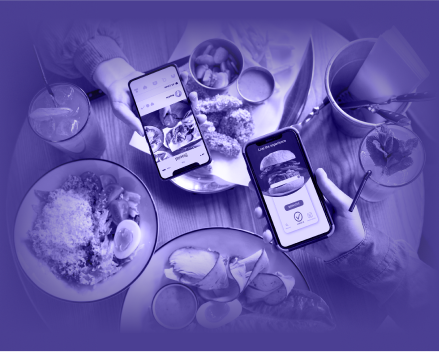
Lunch rush hits. Phone lines jam. Hosts juggle walk-ins and online bookings. Guests want answers now.
That gap between intent and action is where a smart chatbot earns its keep.
A well planned solution handles reservations, menu questions, allergen checks, order status, and simple upsells. It never calls in sick. It keeps tone on brand. It frees your team for the moments that matter.
The market signals are clear. The global restaurant chatbot market is projected to reach $1.3 billion by 2028 with a CAGR of over 20%, according to a report by Market Research Future. Salesforce claims that across industries, 62% of consumers prefer engaging with a chatbot over waiting for a human agent. For restaurants, that preference translates into faster bookings, smoother order flows, and stronger loyalty programs.
For owners and tech leads, the value shows up in clear numbers. Faster responses. Fewer no-shows. Higher average order value. Lower support costs. Consistent service on every channel.
This guide walks through the full path of restaurant AI chatbot development. Strategy first. Features next. Then stack choices, costs, rollout, and optimization. Everything you need to go from idea to a working system that guests actually use.
Restaurants looking to get started often turn to an AI chatbot development company that understands both hospitality and technology. And for leaders mapping a bigger digital strategy, knowing how to build an AI app offers perspective on the architecture and decisions that surround chatbot development.
At its core, restaurant chatbot development is the process of designing, training, and integrating an automated digital assistant that communicates with guests through text or voice. Instead of calling to ask if a table is free, a customer can confirm availability instantly. Instead of scrolling through a PDF menu, they can interact with a bot that highlights today’s specials and even suggests pairings.
These chatbots aren’t just rule-based responders. They rely on natural language understanding to interpret customer intent. That means when a guest types “book a table for two at 7,” the chatbot processes the request and confirms the reservation without manual input. The same applies to food orders, delivery status updates, or quick answers about allergens.
For restaurants, the real advantage comes when chatbots are linked with point-of-sale systems, loyalty programs, or third-party delivery apps. That’s where AI automation services create tangible value - streamlining the entire customer journey from browsing the menu to post-meal feedback.
When built with scalability in mind, these solutions can also connect with other tools in your digital ecosystem.
Modern diners expect quick answers, smooth ordering, and a personalized touch at every interaction. AI chatbots deliver this by streamlining reservations, providing accurate menu guidance, and engaging customers across multiple platforms, helping restaurants strengthen relationships and drive measurable business growth.
Here’s why you should invest in AI chatbots for your restaurant to ensure better customer engagement:
Customers no longer have to wait until business hours to book a table or ask about opening times. A chatbot provides instant support at midnight just as reliably as it does during lunch. This convenience builds trust and sets a higher service standard. Restaurants that work with a custom software development company often ensure these systems scale smoothly without compromising reliability.
AI-driven bots can recall past orders, favorite dishes, or dining preferences. When a returning guest opens the menu, the chatbot can highlight their usual choices or suggest new pairings. That personal touch makes customers feel remembered and valued. Many businesses achieve this by deploying an adaptive AI agent that learns from each interaction.
Handling repetitive queries about hours, directions, or menu details often consumes staff time. Chatbots take over these routine tasks, allowing employees to focus on high-value interactions like service quality and guest experience. The result is less stress for staff and more satisfaction for guests. Scaling this across chains becomes easier with enterprise AI solutions that unify operations across multiple locations.
Smart chatbots do more than answer questions. They can suggest appetizers with entrées, promote seasonal specials, or recommend upgrades during checkout. These nudges raise average ticket sizes without feeling intrusive. Success often comes when restaurants integrate AI into an app connected to POS and loyalty systems, ensuring offers are both timely and relevant.
Every interaction tells a story about customer behavior. Chatbots can highlight peak ordering hours, track popular dishes, and capture valuable feedback in real time. These insights help managers adjust staffing, optimize menus, and refine marketing campaigns. Refining this process often involves ongoing AI model development so the bot interprets requests more accurately over time.
Restaurants that view chatbots as engagement drivers, see stronger brand loyalty and higher retention. The real strength lies in building a system that feels helpful, personal, and seamless.
With the foundation clear, it’s time to look at the different types of restaurant chatbots and how each fits a specific business model.
Develop AI chatbot for restaurants that streamlines reservations, answers FAQs, and boosts guest satisfaction around the clock.
Start My AI Restaurant Chatbot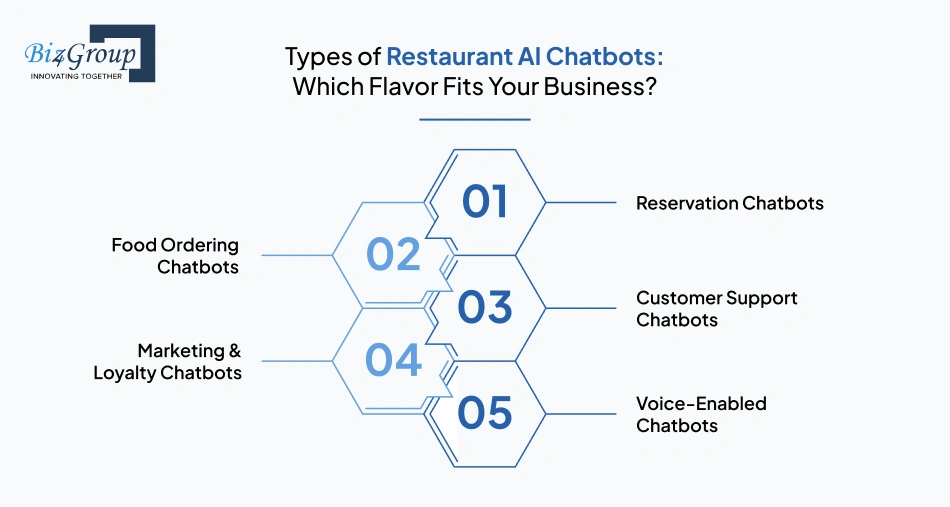
Not every restaurant needs the same kind of chatbot. A quick-service pizza chain, a fine-dining bistro, and a food delivery platform all serve different customer journeys. Understanding the main types of chatbots helps decision-makers choose the right fit and avoid investing in features that don’t match their needs.
These AI chatbots manage bookings, cancellations, and waitlists automatically. They integrate with calendars and POS systems to reduce no-shows and optimize table turnover. Many restaurants hire AI developers to customize reservation flows and ensure they align with brand-specific requirements.
Ordering bots let customers browse menus, customize meals, and place delivery or pickup requests. They also suggest add-ons and combos at checkout to increase average ticket size. Restaurants often rely on an AI-based food ordering chatbot to connect their digital menu with loyalty systems and delivery partners.
Support bots answer FAQs about hours, allergen details, or directions. By automating these repetitive questions, they reduce pressure on staff and provide consistent customer service. Many restaurants leverage these solutions as a full AI conversation app capable of managing thousands of inquiries at scale.
These bots deliver personalized offers, send loyalty rewards, and promote seasonal campaigns directly through messaging platforms. They help keep customer engagement active even when guests aren’t dining in. Restaurants often integrate these functions using business app development with AI to sync with CRM data for precise targeting.
Voice-first bots provide hands-free ordering, making them ideal for drive-thrus or smart speaker integrations. They enhance accessibility and speed, especially during busy service hours. Many forward-looking restaurants build AI chatbot voice assistants to align with customer adoption of Alexa, Siri, and Google Assistant.
Each chatbot type addresses a different operational need, from streamlining orders to nurturing loyalty. Matching the right type to your restaurant’s goals ensures the system fits your operations and customer expectations.
Once the right type is identified, the real payoff comes from understanding the benefits these chatbots deliver to both guests and restaurant owners.
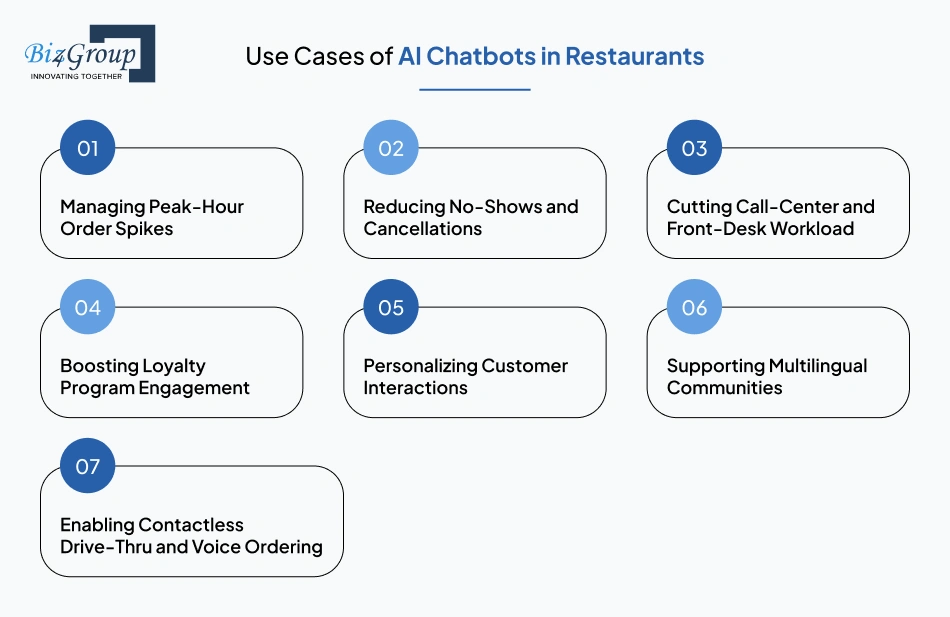
Restaurants are not deploying AI chatbots just to look modern. They are using them to solve real operational challenges. From tackling peak-hour rush to strengthening customer loyalty, these use cases show how chatbots deliver measurable business value.
During dinner rush, phone lines and counters get overloaded. An AI chatbot can take dozens of orders simultaneously, reducing delays and lost opportunities. This kind of automation works best when part of on-demand app development solutions that allow restaurants to scale during peak hours.
Missed reservations cost restaurants significant revenue. AI chatbots automatically send reminders, manage confirmations, and handle cancellations in real time. With smarter generative AI models, they can even phrase reminders in a more natural, human-like tone.
Answering repetitive questions about hours, menu details, or directions takes staff away from hospitality. Chatbots instantly resolve these common queries. Restaurants working with an AI development company can integrate bots into existing systems so the experience feels seamless.
Guests often forget about points or promotions. Chatbots can push timely reminders and suggest reward redemptions while a customer is placing an order. When tied to generative AI agents, the system learns customer habits and tailors loyalty nudges more effectively.
Remembering a guest’s past orders or preferences makes them feel valued. An AI chatbot can highlight their usual dish or suggest pairings based on purchase history. This personalization builds stronger connections while boosting order value.
For diverse neighborhoods or tourist-heavy areas, restaurant AI chatbots can communicate in multiple languages. This eliminates friction for guests and makes ordering feel inclusive.
Voice-enabled AI chatbots allow guests to place hands-free orders at drive-thrus or through smart speakers. Faster service and smoother transactions improve guest convenience and keep lines moving.
These use cases prove that chatbots are more than a digital convenience. They are practical tools that address real restaurant challenges while shaping better dining experiences.
With their impact established via use cases, the next step is to explore the specific benefits that make AI chatbots essential for modern restaurants.
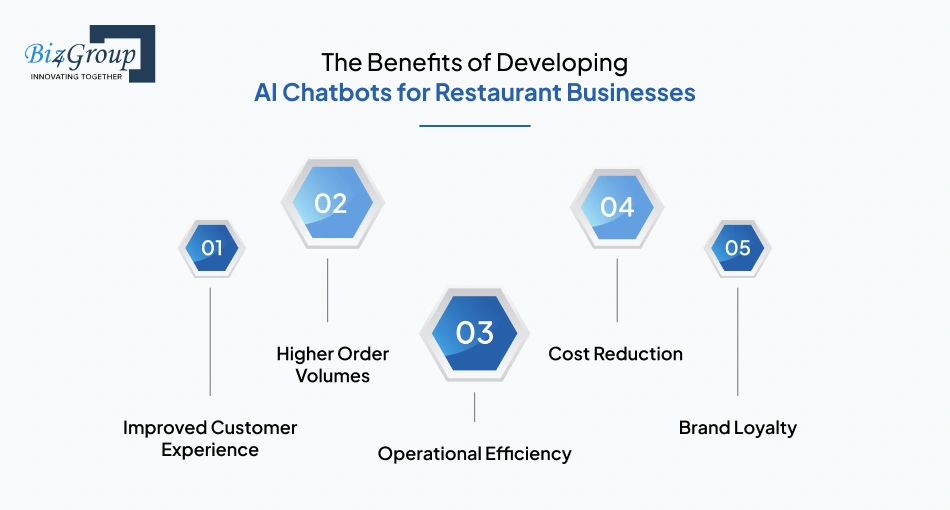
When a hungry customer opens your website at midnight, craving their favorite dish. Instead of waiting until morning to call, a chatbot confirms a table or takes an order instantly.
That simple exchange not only saves a sale but also builds trust. For restaurants, these moments add up - boosting efficiency, cutting costs, and creating memorable guest experiences.
AI chatbots respond instantly, whether it’s confirming a reservation or answering a menu query. That reliability reduces wait times and frustration, giving guests more confidence in the brand. When paired with AI model development, the system can interpret nuanced customer requests and provide more accurate, human-like responses.
Food ordering AI chatbots actively encourage larger basket sizes. By suggesting sides, drinks, or promotions during checkout, they help restaurants increase average ticket value. Building these capabilities as part of a wider plan to build AI software ensures the system is scalable and flexible enough to grow with business demand.
By handling repetitive tasks like order status updates or FAQs, AI chatbots reduce workload for frontline staff. Employees can focus on service quality while the bot manages routine queries. This balance leads to smoother operations, especially during peak hours.
AI chatbots minimize the need for additional staff during busy periods. Instead of hiring extra phone operators or hosts, the chatbot fills the gap at a fraction of the cost. Over time, the savings compound into significant financial benefits.
By remembering past orders and offering personalized promotions, restaurant AI chatbots create stronger customer connections. Loyalty programs managed through chat interfaces keep guests engaged even between visits. This kind of interaction encourages repeat business and word-of-mouth recommendations.
Seeing how AI chatbots are applied in real restaurant scenarios makes their value clear. But success does not come from simply having a chatbot in place. It depends on what the chatbot can actually do for customers and staff.
The next step is to look at the features that separate a basic chatbot from one that truly transforms the dining experience.
Restaurant AI chatbot development helps you upsell, personalize offers, and engage customers at scale for higher revenue.
Build My AI Chatbot NowA restaurant chatbot should feel like part of the dining experience, not just a tech add-on. From simplifying reservations to creating personalized recommendations, the right features make the difference between a tool customers tolerate and one they genuinely enjoy using. These are the must-have and advanced features that every restaurant should consider.
Guests want to book, confirm, or cancel tables instantly without calling. A chatbot with reservation capability reduces missed opportunities and eases pressure on front-of-house staff. When connected to calendars and POS systems, it keeps seat availability accurate at all times.
Customers prefer exploring menus directly in chat instead of downloading static PDFs. High-quality photos, pricing, and dietary tags make it easier to decide what to order. Many restaurants now adopt an AI menu management system for restaurants so digital menus remain consistent across websites, apps, and delivery partners.
A strong chatbot allows diners to place orders and tailor them to their preferences. From choosing portion sizes to adding sides, the process should feel intuitive. When paired with delivery integrations, it ensures a frictionless path from browsing to checkout.
Customers trust restaurants that allow safe payments within the chat. Built-in gateways for cards, wallets, or contactless payments eliminate unnecessary friction. This convenience increases completed orders and builds customer confidence.
Once food is ordered, customers expect updates without needing to call. A chatbot that shares real-time order status keeps guests informed and reassured. It also reduces staff time spent answering “where is my food” queries.
Serving diverse communities means accommodating different languages. AI chatbots that translate responses make every customer feel understood. This feature is especially valuable for restaurants in tourist-heavy areas.
Guests often ask the same basic questions about hours, allergens, or parking. Automating these answers saves staff time and keeps service consistent. Restaurants that prioritize AI-powered human-like customer support ensure their bots respond in a way that feels natural and brand-aligned.
AI Chatbots tied to loyalty programs help customers track and redeem points. They can push reminders about unused rewards or promote exclusive member deals. This constant engagement encourages repeat visits and deeper brand loyalty.
Well-designed AI chatbots can suggest sides, drinks, or combos while customers order. These subtle nudges increase order value without overwhelming the guest. As highlighted in business app development using AI, upselling works best when data-driven and tailored to customer habits.
Modern customers expect brands to remember them. AI chatbots that recall past orders or highlight favorite dishes create a sense of familiarity. More advanced personalization often involves building agentic AI, enabling the chatbot to act with autonomy and adapt dynamically to user needs.
Typing isn’t always convenient for customers on the go. Voice-enabled chatbots let guests place orders hands-free in drive-thrus or via smart speakers. This feature also improves accessibility for visually impaired diners.
Every chatbot interaction generates valuable data. A dashboard helps managers see peak hours, top-selling items, and customer satisfaction trends. These insights support better staffing, marketing, and menu planning decisions.
A chatbot must work smoothly with existing systems to avoid silos. Integration with POS, CRM, and delivery apps creates a unified operation. Our blog on AI chatbot integration in various industries shows how restaurants can learn from other sectors to build more robust solutions.
Quick Summary Table: Features to Consider When Building AI Restaurant Chatbots
| Feature | What It Does | Why It Matters |
|---|---|---|
|
Easy Table Reservations |
Lets customers book, confirm, or cancel instantly. |
Reduces no-shows and staff workload. |
|
Interactive Menu Browsing |
Shows menu with images, pricing, and dietary filters. |
Helps guests decide quickly and improves upselling. |
|
Food Ordering & Customization |
Enables direct ordering with options for personalization. |
Simplifies the customer journey and increases order volume. |
|
Secure Payment Options |
Integrates cards, wallets, and contactless payments. |
Builds trust and reduces checkout friction. |
|
Real-Time Order Tracking |
Provides live updates on order status. |
Cuts “where’s my order” calls and keeps customers reassured. |
|
Multi-Language Support |
Supports multiple languages in chat. |
Expands accessibility in diverse or tourist-heavy markets. |
|
Customer Support & FAQs |
Automates answers to routine questions. |
Frees staff to focus on hospitality. |
|
Loyalty Program Integration |
Connects AI chatbots with rewards programs. |
Encourages repeat visits and brand loyalty. |
|
Smart Upselling & Cross-Selling |
Suggests sides, drinks, or combos during checkout. |
Increases average ticket size. |
|
Personalization with AI |
Remembers past orders and preferences. |
Makes customers feel valued and boosts engagement. |
|
Voice Ordering Capabilities |
Enables hands-free orders through voice. |
Improves convenience in drive-thrus and accessibility. |
|
Analytics & Insights Dashboard |
Tracks interactions, sales, and satisfaction metrics. |
Supports data-driven menu, staffing, and marketing decisions. |
|
Seamless System Integration |
Connects chatbot with POS, CRM, and delivery apps. |
Creates a unified and scalable digital ecosystem. |
Successful AI chatbots are defined not by how many features they have but by how effectively those features improve customer journeys. From fast reservations to intelligent upselling, every capability should serve a clear purpose. With the right features outlined, the next step is building a structured roadmap to bring them to life.
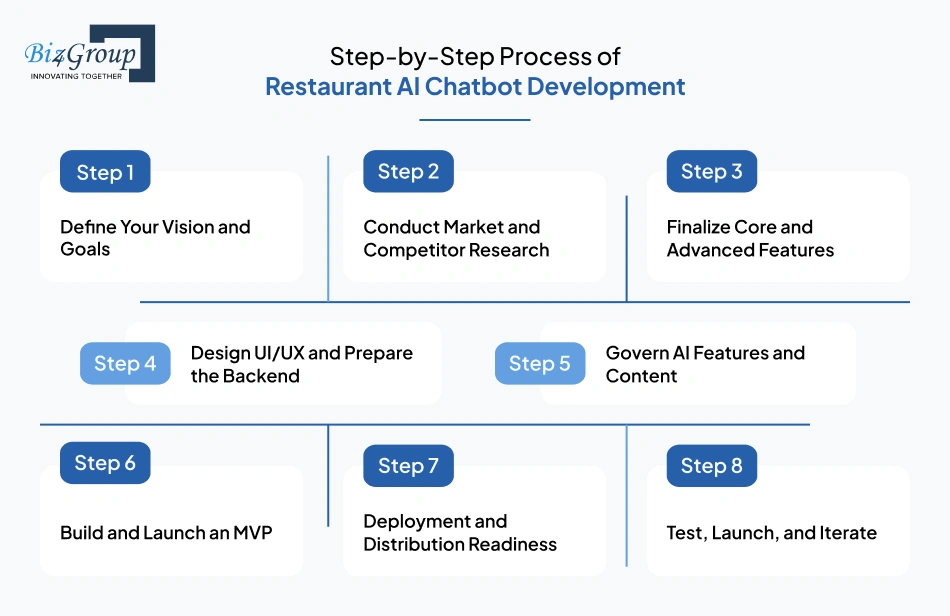
Developing a restaurant chatbot isn’t just about coding. It’s about following a structured plan that ensures the bot is easy to use, integrates well with your systems, and delivers measurable business value. Here’s how to approach it step by step.
Start by outlining what the chatbot should achieve. Is the priority to cut phone calls, improve reservation management, or increase digital orders? A clear vision keeps the project aligned with business outcomes.
Study how other restaurants use AI chatbots and identify gaps you can fill. Competitor insights will guide which features to prioritize and how to stand out. This step ensures you don’t reinvent the wheel.
Choose a balance of must-have and advanced features. Essentials like reservations, menu browsing, and payments form the foundation, while advanced tools such as personalization and analytics bring extra value. This clarity avoids scope creep and wasted effort.
A chatbot succeeds when it looks inviting and feels intuitive. Strong UI/UX design makes it easy for customers to book, order, or ask questions, while a solid backend ensures the system runs smoothly with POS and CRM integrations. Partnering with experts at this stage helps avoid clunky user flows.
Also Read: Top UI/UX design companies in USA
Set rules for how the chatbot communicates. Define its tone, escalation points, and the kind of information it can share. Good governance protects your brand’s voice and ensures responses stay accurate.
Instead of going live with a massive feature set, start small with an MVP. Focus on core functions like reservations and FAQs to validate usefulness quickly. Partnering with experts in MVP development ensures a structured rollout that can scale.
Also Read: Custom MVP Software Development
Place the chatbot where it will be most useful, starting with your website. Expand later to mobile apps, social media, and delivery platforms. Following a guide on how to integrate AI chatbot in website helps ensure a smooth and secure setup.
Testing ensures a smooth customer experience at launch. Pilot with one location or audience before expanding to all restaurants. Continuous iteration keeps the chatbot fresh and relevant as guest expectations evolve.
With development steps mapped out, the next big decision is choosing the right tech stack that will power the chatbot reliably at scale.
Also Read: Top Software Testing Companies in USA
The success of a restaurant chatbot depends on more than its features. The underlying tech stack determines how fast it responds, how easily it integrates with existing systems, and how well it scales with growing demand. Choosing the right components ensures your chatbot runs smoothly while delivering a consistent guest experience.
| Layer | Technologies/Tools | Why It Matters for Restaurants |
|---|---|---|
|
Frontend (UI/UX) |
Creates a responsive, fast, and intuitive interface. Next.js adds SEO benefits, especially for AI chatbots embedded in restaurant websites. |
|
|
Backend |
Handles chatbot logic, order processing, and integrations with restaurant systems. |
|
|
NLP Engine |
Dialogflow, Rasa, Microsoft Bot Framework, IBM Watson |
Interprets natural language, enabling the chatbot to understand complex customer queries accurately. |
|
Databases |
MongoDB, PostgreSQL, MySQL |
Stores reservation details, menu data, and customer profiles securely. |
|
Integrations |
POS systems (Toast, Square), CRM tools, Delivery APIs (Uber Eats, DoorDash, Grubhub) |
Ensures seamless syncing of reservations, payments, and delivery logistics. |
|
Payment Gateways |
Stripe, PayPal, Square |
Provides secure and reliable in-chat payment options. |
|
Hosting & Deployment |
AWS, Google Cloud, Microsoft Azure |
Delivers scalability and uptime reliability, even during peak restaurant hours. |
|
Analytics & Monitoring |
Google Analytics, Power BI, custom dashboards |
Tracks chatbot performance, customer behavior, and operational insights for continuous improvement. |
Selecting the right tech stack lays the foundation for performance and scalability, but technology alone does not guarantee success. What truly matters is how you use best practices to guide development and avoid costly mistakes.
Next, let’s look at the best practices that make restaurant chatbot projects successful in the real world.
From MVP builds to enterprise AI solutions, our experts design scalable AI chatbots that integrate seamlessly with POS and delivery systems.
Get My AI Roadmap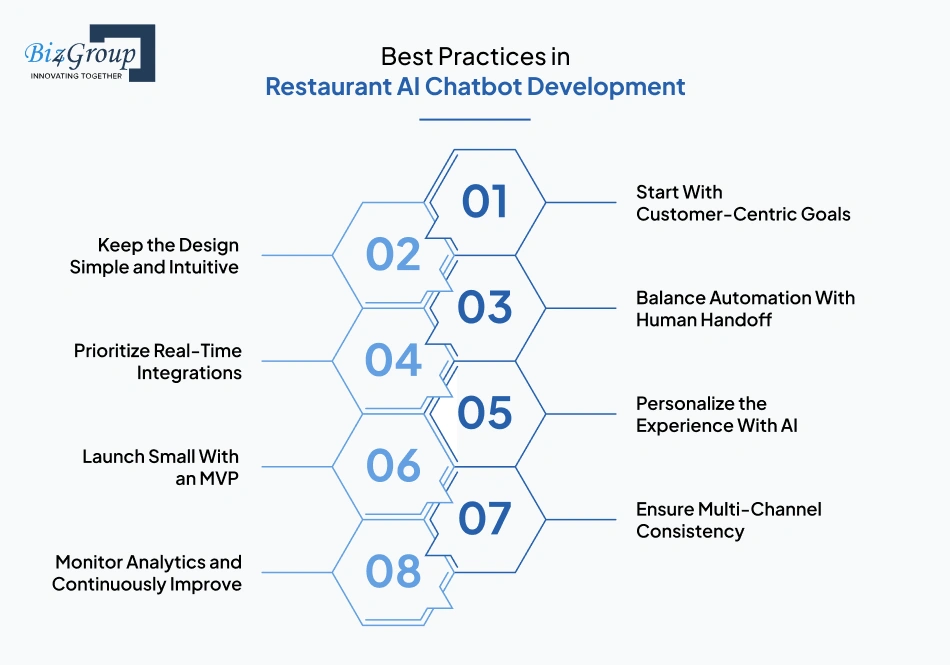
A restaurant chatbot should feel less like a piece of software and more like a helpful assistant. The right practices ensure it solves customer problems, supports staff, and delivers an experience that feels smooth and reliable. By following these principles, restaurants can avoid wasted effort and create AI chatbots that truly add value.
The most effective AI chatbots are designed around guest needs, not just business metrics. Whether it’s making reservations easier or reducing wait times for orders, the focus should always be on solving customer pain points. When KPIs align with guest satisfaction, success is easier to measure.
An overcomplicated chatbot is a fast way to lose customers. Flows should be clear, navigation should feel effortless, and responses should stay consistent in tone. Working with a custom software development company ensures the design and functionality align seamlessly with your brand’s digital presence.
While automation saves time, not every situation can be resolved by AI. Complex scenarios like large catering requests should quickly escalate to a human staff member. Smooth handoffs maintain trust and prevent frustration when the chatbot reaches its limits.
Disconnected AI chatbots are prone to mistakes. Integration with POS, CRM, and delivery systems ensures the chatbot always shares accurate menu details, seat availability, and order updates. Partnering with specialists in AI integration services helps avoid errors and guarantees reliable performance.
Guests expect digital interactions to reflect their preferences. Remembering past orders, suggesting relevant dishes, or offering personalized deals makes them feel valued. Personalization also encourages repeat visits and boosts order value when applied thoughtfully.
Instead of overwhelming guests with a feature-heavy chatbot, start small with a focused version. An MVP allows you to test, gather feedback, and refine before expanding. Scaling gradually ensures quality is maintained while new features are added.
Your guests interact across websites, apps, and social channels, and they expect the same experience everywhere. A consistent tone, design, and feature set across platforms builds credibility. This consistency reassures customers that they’re dealing with the same brand, no matter the channel.
AI chatbots must evolve with customer behavior. Reviewing transcripts, tracking conversion rates, and studying drop-off points help identify areas for improvement. Regular updates keep the chatbot fresh, relevant, and effective in meeting guest needs.
Best practices are not about flashy features but about creating a chatbot that consistently adds value. A strong foundation ensures long-term success, but avoiding costly errors is equally critical. Let’s explore the common mistakes restaurants should avoid in AI chatbot development.
Even the smartest chatbot can fall short if the foundation isn’t right. Many restaurants rush into development and overlook key details that directly affect customer satisfaction and ROI. Avoiding these common pitfalls helps ensure your chatbot delivers value from day one.
A chatbot that displays outdated menus or incorrect availability creates instant frustration. Guests expect real-time accuracy when browsing dishes or booking tables. This is why many restaurants adopt enterprise AI solutions that prioritize system-wide integration and up-to-date data syncing.
Overloading the chatbot with endless options or long flows makes it harder for guests to get what they need. Customers want quick answers, not a maze of menus. A streamlined design ensures conversations stay simple and effective.
AI chatbots often work in theory but break when tested by real customers. Skipping pilot testing leads to missed issues like unclear language or clunky flows. As emphasized in our guide to AI chatbot development, testing early and often is essential for building reliable customer-facing bots.
A chatbot should continuously evolve, but that only happens with proper tracking. Without analyzing drop-offs, response times, or satisfaction scores, restaurants miss opportunities to improve. Ignoring analytics makes the chatbot stale and less effective over time.
Some restaurants treat AI chatbots as a quick way to reduce staffing costs. While automation can save money, an impersonal chatbot often drives customers away. The true value lies in balancing efficiency with a better dining experience.
It is tempting to let the chatbot handle everything, but no system can cover every scenario. Complex cases like catering orders or special requests often require staff involvement. Without a clear handoff, customers feel stranded and lose trust in the restaurant.
Avoiding these mistakes keeps your chatbot from becoming another forgettable gimmick. When designed thoughtfully, it becomes a trusted assistant that builds loyalty and improves efficiency. With pitfalls covered, the next focus is on the cost breakdown of building a restaurant AI chatbot for reservations.
The cost of building a restaurant AI chatbot generally falls between $30,000 and $400,000+, depending on complexity, integrations, and scale. If you’re wondering what’s the cost of AI app development for restaurants, expenses seem to rise significantly as you move from basic reservation bots to enterprise-grade systems with advanced features. A simple bot covers the essentials, while advanced solutions with loyalty programs, voice ordering, and analytics require larger investments. Restaurants should treat chatbot development as a strategic investment that drives both efficiency and customer satisfaction.
| Level | Features Included | Estimated Cost (USD) |
|---|---|---|
|
Basic Chatbot |
Manages reservations, FAQs, and simple menu browsing with limited backend integration. |
$30,000 – $60,000 |
|
Mid-Level Chatbot |
Adds real-time POS/CRM integration, payment processing, personalization, and multi-channel support. |
$60,000 – $150,000 |
|
Advanced Chatbot |
Includes loyalty integration, multilingual support, voice ordering, advanced analytics, and scalability across chains. |
$150,000 – $400,000+ |
The more features you add, the higher the development cost. Basic bots handle reservations and FAQs, while advanced ones include payments, loyalty rewards, or AI-driven personalization. Each new feature requires extra design, coding, and testing, which directly increases budget.
Integrations with POS, CRM, or delivery platforms are among the most resource-intensive parts of development. These connections ensure real-time accuracy for menu availability, order tracking, and loyalty points. The deeper the integration, the more time and expertise required, which raises overall cost.
A chatbot built for one restaurant location can remain lightweight and relatively inexpensive. However, enterprise-grade bots must handle scalability, compliance, and uptime across multiple outlets. If you’re a businesses exploring multi-location deployments, it's recommended that you refer to our blog on enterprise AI chatbot development cost to understand additional expenses.
The cost of a chatbot does not stop at launch. Restaurants must budget for regular updates to menus, training data, and integrations. Ongoing analytics and monitoring ensure the system stays accurate and continues delivering value over time.
While cost is important, it’s only one side of the equation. The real value of a chatbot lies in how quickly it drives growth through more orders, smoother reservations, and stronger customer loyalty.
That’s why the next step is exploring how to monetize your restaurant chatbot for business growth.
Know the real cost of AI chatbot development and launch a solution that delivers measurable ROI without wasted effort.
Estimate My Chatbot Cost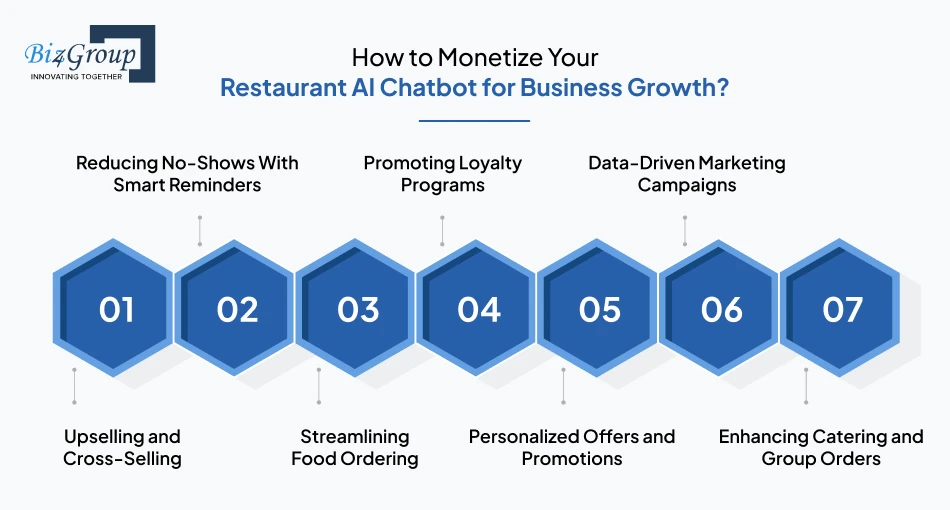
An AI chatbot isn’t just a cost center; it can directly boost revenue and customer loyalty if designed strategically. From upselling menu items to capturing repeat customers through loyalty programs, the right chatbot implementation creates measurable business outcomes. The key is to think beyond automation and treat the chatbot as a revenue-generating channel.
AI hatbots can suggest sides, drinks, or desserts when customers place an order, increasing the average ticket size. Intelligent recommendations feel natural because they are tied to customer preferences or order history. This mirrors the effectiveness of a skilled server who knows how to enhance the dining experience.
Reservation no-shows cost restaurants significant revenue. Automated confirmations and reminders via chatbots reduce this risk by nudging guests to show up or cancel in advance. A more consistent reservation flow helps maximize table utilization.
AI chatbots simplify online ordering, enabling customers to quickly browse menus, customize meals, and pay securely. The convenience improves order frequency and strengthens loyalty among digital-first diners. Many restaurants are already experimenting with an AI-based food ordering chatbot to capture this growing market.
A chatbot can highlight loyalty rewards during interactions, encouraging signups and repeat visits. By linking points and personalized deals, it turns casual diners into long-term customers. Loyalty engagement through automation makes rewards feel immediate and rewarding.
Generative AI allows chatbots to craft unique, conversational promotions tailored to each guest. Instead of generic deals, customers receive suggestions aligned with their tastes and past orders. Leveraging generative AI makes promotions feel like recommendations from a friend rather than a sales push.
AI chatbots capture valuable data on customer preferences, behavior, and ordering trends. This insight can be used to design targeted campaigns that are far more effective than blanket advertising. Data-driven personalization turns one-time visitors into loyal brand advocates.
Chatbots make it easier for customers to book catering or large party orders. Automating these processes reduces staff workload while unlocking higher-value sales. It ensures big-ticket events are handled smoothly and without friction.
When built strategically, restaurant AI chatbots become more than digital assistants—they turn into active revenue drivers. Monetization opportunities lie in smart design, customer-focused personalization, and data-driven insights.
With revenue potential mapped out, the next challenge to tackle is the obstacles restaurants face in developing AI chatbots successfully.
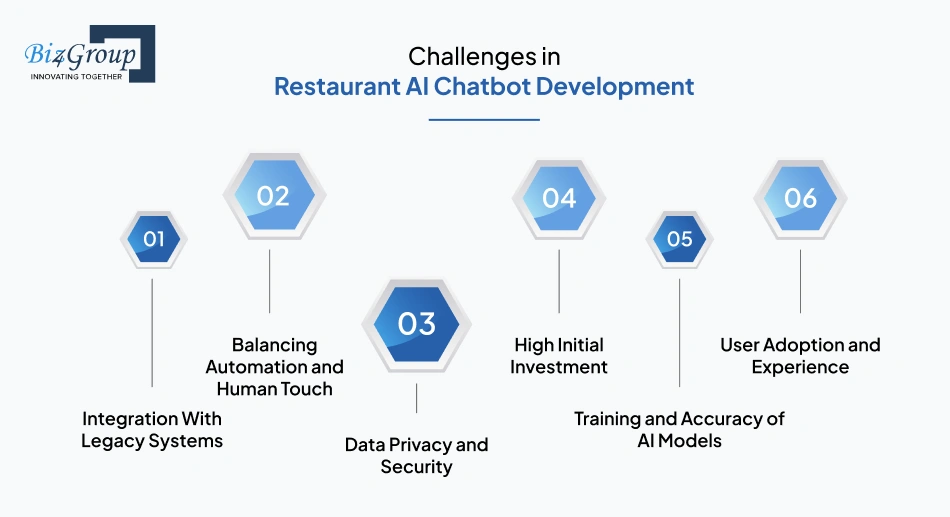
Building a restaurant chatbot goes beyond coding a few conversation flows. Restaurants face challenges in integration, training, and adoption that can limit success if not addressed properly. By identifying these obstacles early and applying practical solutions, businesses can build AI chatbots that deliver real results.
| Challenge | Why It’s a Problem | How to Solve It |
|---|---|---|
|
Integration With Legacy Systems |
Many restaurants still use outdated POS and booking systems, making it difficult for AI chatbots to access accurate real-time data. |
Use middleware or APIs to bridge old systems with modern platforms, ensuring seamless data flow. |
|
Balancing Automation and Human Touch |
Over-automation risks making interactions feel impersonal, frustrating guests with complex needs. |
Design escalation paths that transfer customers to staff smoothly while letting the chatbot handle routine tasks. |
|
Data Privacy and Security |
Handling personal and payment details creates compliance and trust concerns. |
Implement end-to-end encryption, follow PCI and GDPR standards, and update security protocols regularly. |
|
High Initial Investment |
Advanced chatbot development requires a large upfront budget, which can intimidate smaller restaurants. |
Build in phases, starting with an MVP, and calculate ROI projections to show long-term savings and revenue gains. |
|
Training and Accuracy of AI Models |
Poor training data results in irrelevant or unhelpful chatbot responses. |
Use domain-specific datasets and frameworks like generative AI agents to improve contextual understanding. |
|
User Adoption and Experience |
Even strong chatbots fail if customers don’t find them easy or useful. |
Prioritize intuitive design, run user testing before launch, and promote the chatbot through customer touchpoints. |
Every challenge in chatbot development has a solution, provided restaurants approach it strategically. By planning for integration, training, and adoption early, businesses can create tools that delight guests and boost efficiency.
With obstacles covered, it’s time to look forward to the future of restaurant AI chatbot development and what innovations lie ahead.
Imagine a customer on their way home asks their car’s assistant to reorder last week’s takeout, and by the time they arrive, the food is ready at the curbside.
That’s where restaurant AI chatbots are headed. The next wave of innovation will make these digital assistants smarter, faster, and more proactive, turning them into growth engines for restaurants rather than just service tools.
We’re moving into a world where customers expect to order with their voice, whether it’s through a smart speaker, mobile app, or even in the car. Imagine your chatbot taking a drive-thru order before the customer even reaches the window. For restaurants, this means shorter lines, faster service, and happier guests.
The days of generic “Would you like fries with that?” are gone. Future AI chatbots will remember a customer’s favorite drink, suggest a new seasonal item based on their taste, and time promotions so they actually feel relevant. Restaurants investing in business app development using AI will be able to deliver personalization at scale, giving every guest the VIP treatment.
Imagine a chatbot suggesting a family meal deal on Friday night because it knows that’s when the customer usually orders for a group. By linking real-time inventory with ordering trends, these bots won’t just respond - they’ll anticipate. For restaurants, that means less waste, higher upsell potential, and a smoother kitchen workflow.
Today’s bots are reactive, since they wait for the customer to speak. Tomorrow’s bots will be proactive digital managers. Restaurants that will build agentic AI, will also feature AI chatbots that would automatically release loyalty offers on a customer’s birthday, reschedule a reservation if there’s a conflict, or even resolve complaints without staff intervention.
Guests won’t just talk to your chatbot on a website. They’ll find it in their favorite social app, see it pop up in an AR dining menu, or even interact with it in their car’s dashboard. A consistent, omnichannel experience will be the new standard, and restaurants that nail this will win loyalty across platforms.
The future of restaurant AI chatbots is more exciting than ever. They’re evolving from order-takers to intelligent brand ambassadors who can boost revenue, cut costs, and wow guests with every interaction.
For restaurant leaders, the question isn’t if to invest, but how soon - because the businesses that adopt early will set the pace for the entire industry.
For restaurant owners, cafe managers, franchise operators, and food delivery services, the real challenge isn’t just running day-to-day operations. It’s staying ahead in an industry where customer expectations evolve faster than menus. That’s where Biz4Group comes in.
As a trusted AI app development company, we help hospitality businesses use AI to solve everyday problems: faster order processing, smarter inventory, and personalized customer engagement. Our work on Mtiply, an AI-powered menu management system, shows how we translate complex operations into simple, scalable solutions that work across restaurants, franchises, and delivery platforms.
Customer trust is everything in food service, which is why our expertise in building a customer service AI chatbot is especially valuable. From handling reservations and delivery queries to upselling menu items, AI-driven assistants enhance the customer experience while reducing staff load.
Whether you run a quick-service chain or a fine dining establishment, Biz4Group builds AI apps that balance efficiency with customer delight. We don’t just deliver tech. We deliver solutions that help your business scale, stay competitive, and serve smarter.
Leverage agentic AI and next-gen chatbot strategies to anticipate customer needs and keep your brand competitive.
Plan My AI FutureFrom managing reservations to predicting what customers might crave next Friday night, restaurant AI chatbots are no longer just “cool tech.” They are becoming the backbone of smarter dining experiences. The best part is that the technology is already here, waiting for restaurants bold enough to use it.
Whether you want to launch a simple chatbot or go all in with enterprise-grade innovation, choosing the right AI product development company makes the difference between an average bot and a growth-driving digital assistant. And if you are unsure where to begin, Biz4Group’s professional AI consulting services can help chart the roadmap, keeping your investment smart, scalable, and future ready.
So, restaurant AI chatbots are not a question of “if” anymore, they are a question of “when.” The sooner your restaurant embraces them, the faster you will see the payoff in efficiency, loyalty, and revenue.
The development timeline depends on the complexity of the chatbot. A basic reservation and FAQ bot can take 6–8 weeks, while advanced chatbots with multi-language support, loyalty integrations, and voice capabilities may take 4–6 months. Timelines also vary based on integrations with existing POS and CRM systems.
On average, the cost to develop a restaurant AI chatbot ranges from $30,000 to $400,000+. Simple bots that manage reservations and menus fall on the lower end, while advanced bots with personalization, analytics, and predictive ordering push costs higher. The final price depends on features, integrations, and scalability requirements.
Yes, modern AI chatbots are designed to scale across multiple outlets. They can manage location-specific menus, reservation slots, and delivery availability while maintaining a unified brand experience. This makes them especially valuable for franchises and large chains.
Chatbots provide instant responses to questions about menus, reservations, and delivery, which reduces wait times for customers. They can also personalize suggestions based on order history, making guests feel valued. This constant availability and personalization lead to stronger customer engagement and loyalty.
Most chatbots require minimal upkeep once deployed, but regular updates keep them relevant. Restaurants should update menus, train the bot with new queries, and review analytics to improve performance. With the right setup, managing a chatbot becomes a low-effort, high-impact task.
Yes, many restaurant chatbots now include voice ordering features. This allows customers to place orders through mobile apps, smart speakers, or even car infotainment systems. Voice support improves accessibility and enhances the overall ordering experience.
with Biz4Group today!
Our website require some cookies to function properly. Read our privacy policy to know more.